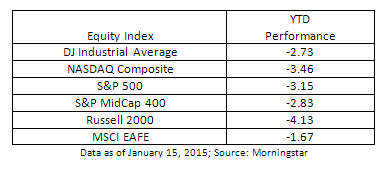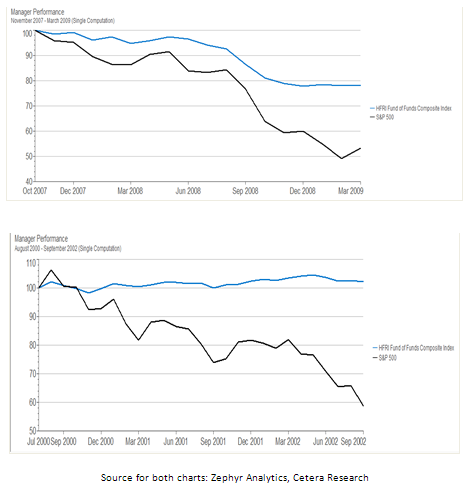Market Commentary - 1.16.15 Using Alternatives to Diversify PortfoliosSo far this year, equities have struggled with most major indices suffering from both selling pressure and increased volatility. As seen in the table below, most asset classes from large-caps to small-caps are in negative territory for the year.
A combination of factors has been driving the equity downturn and uptick in volatility. Commodities, in particular oil and copper, have struggled out of the gate this year and are at multi-year lows. Vulnerability in these commodities suggests concerns about a potentially stagnant global economy. European and Japanese economic data continue to show little, if any, improvement. The Swiss Central Bank unexpectedly scrapped its three-year policy of capping the Swiss franc against the euro in order to reinforce its economy and protect its currency before planned government bond purchases by the European Central Bank. Despite the sharp drop in gasoline prices, which some experts viewed as “tax break,â€쳌 the government reported December retail sales that were far below expectations. Clearly, the financial markets are entering a phase of uncertainty. This really is not too surprising as we noted an increase in volatility in our 2015 Market Outlook.
Looking forward, while equities may reverse course and turn positive, we believe the volatility driven concerns will continue to linger for the balance of this year (and possibly longer). One possible solution to mitigate against elevated volatility is to broaden the investments used in a portfolio beyond traditional investments (stocks and bonds). For example, including lower correlation*, non-traditional investments or alternative strategies including investments such as currencies, commodities, REITs, convertible bonds, and managed futures can improve overall diversification. While traditional investments may target a particular sector of the U.S. equity market or geographic region of the globe, or invest in a long-only manner, alternative strategies are often able to access not only these areas, but also other markets, securities, currencies, or asset classes which complement an existing portfolio of more traditional stocks and bonds. Common alternative strategies include commodities, REITs, absolute return, global macro, market neutral and long/short. As investors continue to seek the optimal blend of risk and reward for investment portfolios, alternative strategies may play a role in accessing the broader investment opportunity set.
As seen in the charts below, alternatives have historically proven to offer some downside protection during the two most recent periods of market weakness – 2008 and 2001-2002. In the below charts, the dark line represents the S&P 500, while the blue line represents a proxy for alternatives, the HFRI Fund of Funds Composite Index. As you can see in both charts, the blue lines (the alternatives) outperformed the S&P 500.
Going forward, we continue to believe market volatility will be elevated and the potential for near-term market weakness will remain. With this in mind, we continue to stress greater levels of diversification in portfolios today. Again, one solution is to include alternative investments in portfolios today. Their lower correlation to traditional investments can offer diversification benefits that could prove helpful during market weakness and/or increased volatility. Markets zig and zag and uncorrelated assets can smooth the ride and may provide better risk adjusted returns in the long run. By smoothing the ride, returns in up markets may be lower, like they were for diversified portfolios in 2014, but the goal is to outperform over a full market cycle with lower volatility (risk). Now may be a good time to add uncorrelated assets, since most underperformed the broad market last year.
A diversified portfolio does not assure a profit or protect against loss in a declining market. All investing involves risk, including the possible loss of principal. There is no assurance that any investment strategy will be successful.
*Correlation is a statistical measure of how two asset classes move in relation to each other. Correlation ranges between -1 and +1. Perfect positive correlation implies that as one asset class moves, either up or down, the other asset class will move in lockstep, in the same direction. Alternatively, perfect negative correlation means that if one asset class moves in either direction the asset class that is perfectly negatively correlated will move in the opposite direction. If the correlation is 0, asset classes have no correlation. This information is compiled by Cetera Investment Management.
About Cetera Investment Management
Cetera Investment Management LLC provides passive and actively managed portfolios across five traditional risk tolerance profiles to the clients of financial advisors, who are affiliated with its family of broker-dealers and registered investment advisers. Cetera Investment Management is part of Cetera Financial Group, Inc., which includes Cetera Advisors LLC, Cetera Advisor Networks LLC, Cetera Financial Specialists LLC, and Cetera Investment Services LLC.
About Cetera Financial Group
Cetera Financial Group, Inc. is the cornerstone of the retail advice division of RCS Capital Corporation (RCS Capital) (NYSE: RCAP), which is focused on serving the needs of investors with best-in-class solutions.
Committed to using its collective knowledge and expertise in service to and for others, Cetera Financial Group is focused on the growth of its affiliated broker-dealers and financial professionals’ businesses by giving them the industry and market insight, technology, resources and solutions they need to better focus on helping their clients pursue their financial goals. For more information, visit cetera.com.
No independent analysis has been performed and the material should not be construed as investment advice. Investment decisions should not be based on this material since the information contained here is a singular update, and prudent investment decisions require the analysis of a much broader collection of facts and context. All information is believed to be from reliable sources; however, we make no representation as to its completeness or accuracy. The opinions expressed are as of the date published and may change without notice. Any forward-looking statements are based on assumptions, may not materialize, and are subject to revision.
All economic and performance information is historical and not indicative of future results. The market indices discussed are unmanaged. Investors cannot directly invest in unmanaged indices. Please consult your financial advisor for more information.
Additional risks are associated with international investing, such as currency fluctuations, political and economic instability, and differences in accounting standards.
Affiliates and subsidiaries and/or officers and employees of Cetera Financial Group or Cetera firms may from time to time acquire, hold or sell a position in the securities mentioned herein. |








